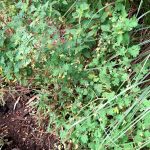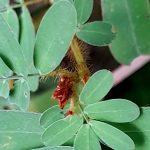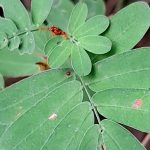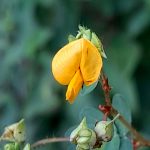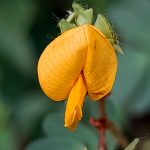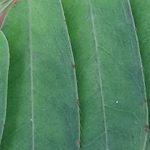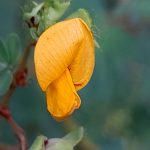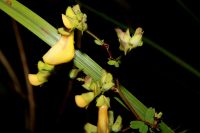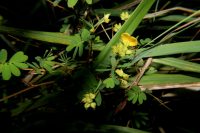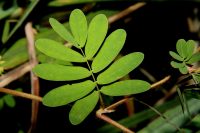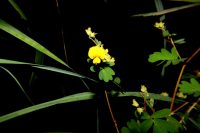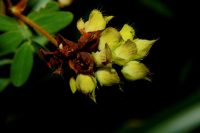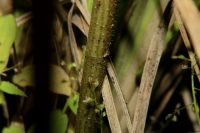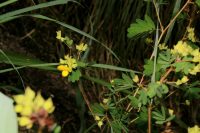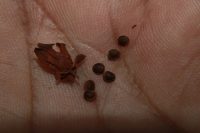|
Smithia blanda Wall., Prodr. Fl. Ind. Orient. 221. 1834. (Syn: Smithia blanda var. paniculata (Arn.) Baker; Smithia blanda var. racemosa (Wight & Arn.) Baker; Smithia bodinieri H.Lev.; Smithia paniculata Arn.; Smithia racemosa Wight & Arn.; Smithia yunnanensis Franch.);
.
Bangladesh (N); China (N); Guizhou ; Sichuan ; Yunnan ; India (N); Assam; Karnataka ; Kerala; Madhaya Pradesh ; Maharashtra; Manipur ; Meghalaya ; Nagaland ; Rajasthan; Sikkim ; Tamil Nadu ; West Bengal; Laos (N) ; Sri Lanka (N) ; Thailand (N) as per ILDIS;
.
Straggling herbs. Leaflets 8-14 x 4-6 mm, obovate, obtuse, glabrous above, sparsely bristly below, ciliate, stipule 10 x 1.5 mm, acuminate at either ends, densely bristly. Racemes paired, 4-8-flowered; peduncles 2-3 cm long, villous; pedicel 4 mm long. Flowers yellow; calyx 4 mm long, smooth; standard 8 x 7 mm, emarginate, clawed; wings 8 x 3 mm, obovate; keel deeply auricled at base. Flowering and fruiting: August-October
Grasslands
South West India and Sri Lanka
(From India Biodiversity Portal (Smithia racemosa Heyne ex Wight & Arn.)
Attributions- Dr. N Sasidharan (Dr. B P Pal Fellow), Kerala Forest Research Institute, Peechi) . Smithia blanda is widely spread in India, China, Laos, Sri Lanka and Thailand. It commonly occurs at an altitude of 1000-2200m. In India, it commonly seen in Tamil Nadu (Coimbatore, Nilgiri, Salem), Kerala (Travancore, Cochin hills at 4000 to 6000ft), Karantaka (Mysore), Assam, Madhya Pradesh (Hoshangabad), Manipur, Meghalaya, Nagaland, Rajasthan, Sikkim, and West Bengal (Henry et al. 1989, Sharma et al. 1984, Sasidharan and Sivarajan 1996, Mudgal et al. 1997).
. Fabaceae-Faboideae (Papilionaceae) Week: RVS18: Smithia for ID:
Please id this Smithia from W.Ghats, near Tirunelveli, TN. The compound leaflets are clearly seen here. The flowers not fully open though. Smithia is a nightmare for me to identify I think it is close to images at Smithia hirsuta Dalzell I now feel that it may be Smithia blanda as per as the hairs of calyx are not coming out of black bases (as is the case with Smithia hirsuta Dalzell).
Pl. see the details with keys at http://florakarnataka.ces.iisc.ac.in/hjcb2/herbsheet.php?id=2087&cat=1
Smithia racemosa is considered as a syn. of Smithia blanda as per The Plant List Ver. 1.1.
…,
You plant appears to be around 40 cm as per your finger size.
Pl. confirm. Considering habit, habitat, bristles on stem and leaflets this too is setulosa. Note forked cymes. In blanda the flowers have to be capitate. Thanks, … But as per the keys at http://florakarnataka.ces.iisc.ac.in/hjcb2/herbsheet.php?id=2087&cat=1, flowers are not to be capitate. Keys is based on whether hairs of calyx are coming out of black bases or not.
Smithia racemosa is considered as a syn. of Smithia blanda as per The Plant List Ver. 1.1. Well. The key I follow says, Thanks, …, What about Smithia racemosa ? S blanda var. racemosa Baker is synonymous with S racemosa Heyne ex Wight & Arn. The plant is most probably S. blanda, can confirm on the basis of microscopic studies of the calyx characteristics. S. blanda shows great variation in different geographical areas.
. 249 ID wild plant: 15 images. Smithia conferta J.E.Smith. ?? Very close dear …, but inflorescence something different, I think it is Smithia blanda Wall. as per images and details herein and as per POWO images and specimens (one and two), Flora of Peninsular India, FoC illustration http://flora-peninsula-indica.ces.iisc.ac.in/herbsheet.php?id=4518&cat=7 Yes, it is very close to Smithia blanda, thank you very much for ID my plant, I don’t see a red patch on the petals in your sp. You are right, dear … The red patches that mentioned by you is at neck which is not visible in my flower because, I think it is in the closing stage (time is 4.00pm). 249 Smithia blanda: After going through the images of Smithia venkobrowii Gamble at POWO and of Smithia blanda Wall. ex Wight & Arn. at POWO, I still feel that your images at 249 ID wild plant. are correctly identified as Smithia blanda Wall. ex Wight & Arn.
Sharing more images.
Date: 23.09.2022, 01.10pm
Location: near Vannappuram Thodupuzha Idukki Dist. Kerala INDIA
4 images. Thank you so much for your mail. In fact it is difficult to confirm the species from these pictures. More close to S. blanda. S. venkobarowii so far reported from few districts in Kerala only. I think these appear to be different from your earlier images. This may be Smithia venkobrowii Gamble as at POWO Thank you very much for ID my plant. This plant is same kind of my earlier plant images (that images captured in evening while flower closing) that growing in same location. Full foliage images also will be provided soon. Sharing images … We have to find out the difference between Smithia venkobrowii and S.blanda Or description of both. Identified as Smithia blanda as per discussions at Smithia blanda ?
To me appears close to images at Smithia blanda I don’t know To further confirm, we have to find out the difference between Smithia venkobrowii and S.blanda or detailed description of both.
Comparing the descriptions of both from IBP:
Going by the above details, I will go for S.blanda.
Yes, it is Smithia blanda, the keys that you provided for S. blanda are very matching, thank you very much for ID confirmation and provides keys of both plants,
. References: POWO images The Plant List Ver. 1.1 ILDIS Flora of China FOC illustration GBIF (with type specimen) India Biodiversity Portal (Smithia racemosa Heyne ex Wight & Arn.) IUCN red List (LC) Flora of Peninsular India India Biodiversity Portal (Smithia blanda Wall. ex Wight & Arn. var. racemosa (Heyne ex Wight & Arn.) Baker) |
Smithia blanda
Updated on December 24, 2024


